Jomon Journey of nawa to yajiri
English is available after Japanese.
For other languages, please click here.
いろんな地域を訪れ、その土地の縄文文化を探求するのは、頭の中に縄文時代の地図をつくるようなものだ。都市だろうと田舎だろうと、たいていの場所に縄文遺跡はある。周辺の川や海岸に行けば石器の原料になった石を見つけることもある。そういった縄文時代のエレメントを脳内にある地図に一つひとつマッピングしていくと、草むらが広がる何もない遺跡に行っても面白がれるようになってきた。そんな旅をはじめたのが、ちょうどこの頃だった。
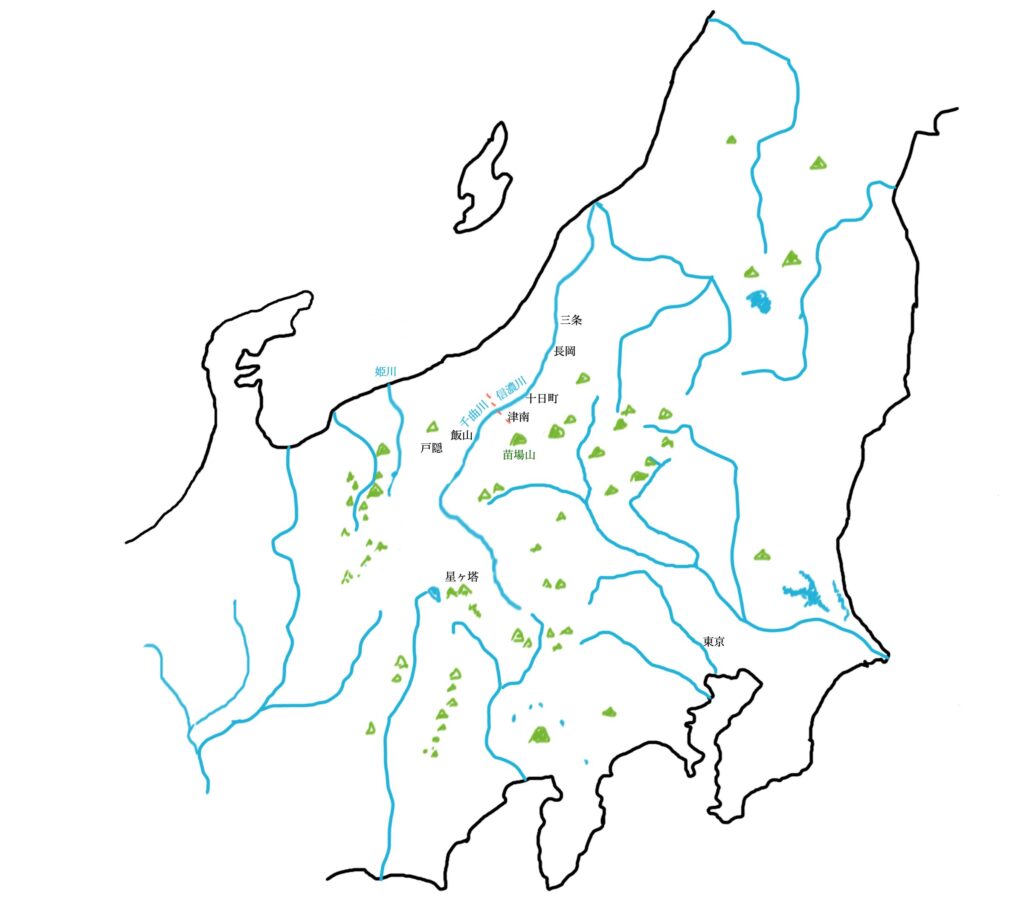
ある年の5月、長野県の戸隠村にあるキャンプ場に行った。この時は初日の夜中に大雨が降り、2ルームテントの前室が水没する事態に。しかし、残りの日程は見事に晴れあがり、戸隠連山の雄大な風景の中をドライブし、名物のそばを食べ、ジオパーク博物館を見つけてディープな地質の世界に浸り、夜は焚き火をして楽しんだ。そして、すっかりキャンプの時間に馴染んだわたしたちは、東京の日常に戻るのが嫌になった。地図アプリで周辺を調べると、戸隠から車で1時間半ほどの距離に火焔型土器(以下、火焔土器)の出土地のひとつ、新潟県津南町があった。意外と近い。早速、津南に隣接する十日町に宿をとった。
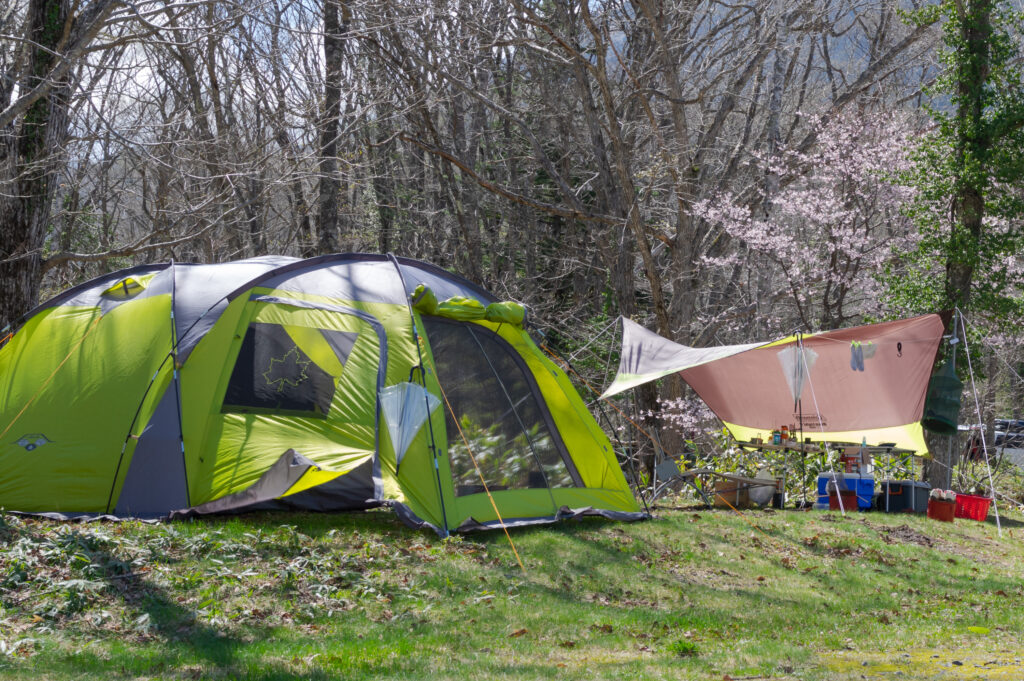
キャンプ道具を車に積み込み、廣川の運転で戸隠村から野尻湖、斑尾高原を抜けて飯山市で千曲川に合流する道を選ぶ。飯山盆地で一度ふくらんだ千曲川は、再び山岳地帯に入り、川幅を細くしていく。その千曲川が信濃川に名前を変える場所が津南町だ。
この頃の私は、縄文時代の道に興味があり、当然川沿いを行く道もあったに違いないと思っていた。なぜなら千曲川の上流部には日本有数の黒曜石産地、星ヶ塔がある。黒曜石は、狩猟生活に欠かせない矢じりの原料で、縄文時代に星ヶ塔の黒曜石は東日本を中心に遠くは北海道まで運ばれていた。その交易ルートのひとつとして、この川を行き来した縄文人もいたのでは……。そんな想像を膨らませるのに新緑の千曲川は最適だった。
やがて新潟県の案内標識が現れ、津南町に入った。「日本一の河岸段丘 津南」と書かれた看板を通り過ぎ、ひなびた市街地を抜けて、農と縄文の体験実習館なじょもんへ。ここへ来るのは二度目だが、入り口に張り付いた巨大な火焔土器のレプリカをみると、火焔のクニに来たという実感が高まってくる。
燃え盛る炎のような形から名付けられた火焔土器。ギザギザに波立つ口縁部に4つの特徴的な鶏頭冠が踊るパワフルなデザインは、いつみても胸をざわつかせる。縄文土器と向き合う時間を「四次元との対話」と言ったのは、芸術家の岡本太郎だが、複雑に入り組んだ渦巻きは、空間をグニャリと歪めるようなサイケデリック感があり、まさに四次元を感じる造形。
これをつくった人々は、よほどぶっ飛んだセンスを持っていたであろう……。しばし、ロビーの展示ケース内の大型火焔土器を満喫する。次に壁際のミニコーナーに行くと、火焔土器が誕生する前後の津南の土器が集められていた。
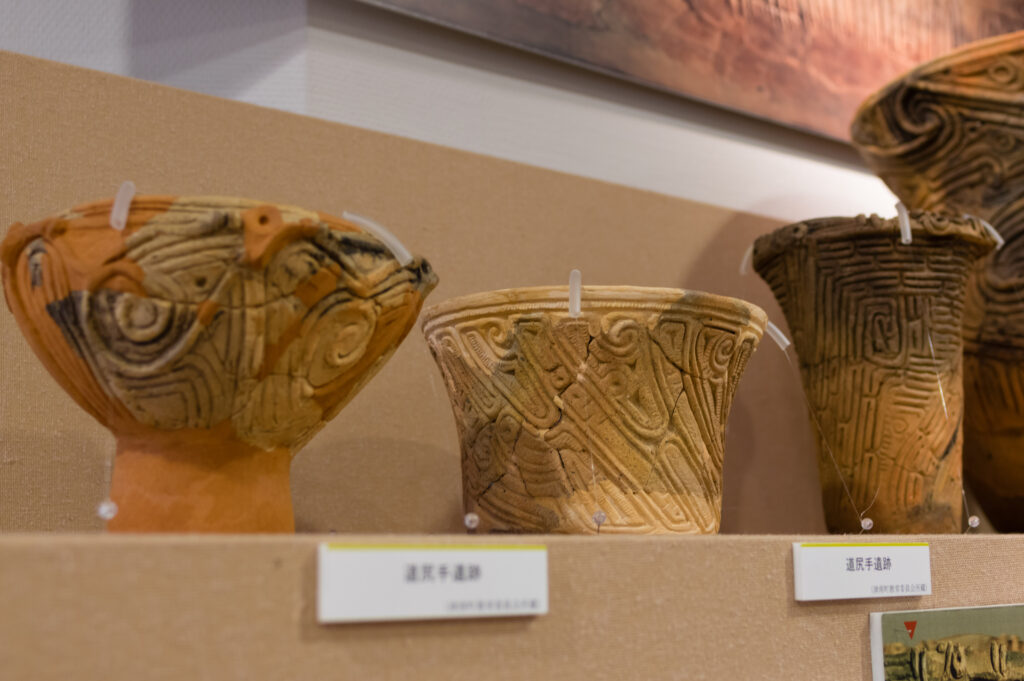
「あれ?」と思った。
そこには、火焔土器で最も装飾過多な頸部から上の部分をスパッと切ったような土器が並んでいたのだ。
その土器は、粘土の白っぽさといい文様の入り方といい、昨年ひとりで北陸を旅したときにみた能登半島の土器に似ていた。能登の土器は全般的にとてもていねいなつくりをしていて、北陸の緻密で繊細なものづくりの源流を感じたものだった。ここ津南にも同じ土器文化が広がっていたのだろうか。
その土器はとてもおしゃれな佇まいをしていた。特徴的な鶏頭冠やギザギザに波立つ口縁部はきれいにカットされていて――カットされたのではなく、もともとあの部分がなかったということなのだけど――、主張がありながらも形はさっぱりしている。火焔土器では垂直に入る隆線が斜めに入れられているのも、洗練された印象を受けた。
しかし、縄文人はこれだけでは何かが足りないと思ったのか、順を追ってみていくと、胴部が細くなり、口縁部に小さなリング状の装飾がつく。さらにごく控えめな突起があらわれる。縁にギザギザと4つの持ち手がつく。そしてあの火焔土器の特徴的な姿になっていくのだ。
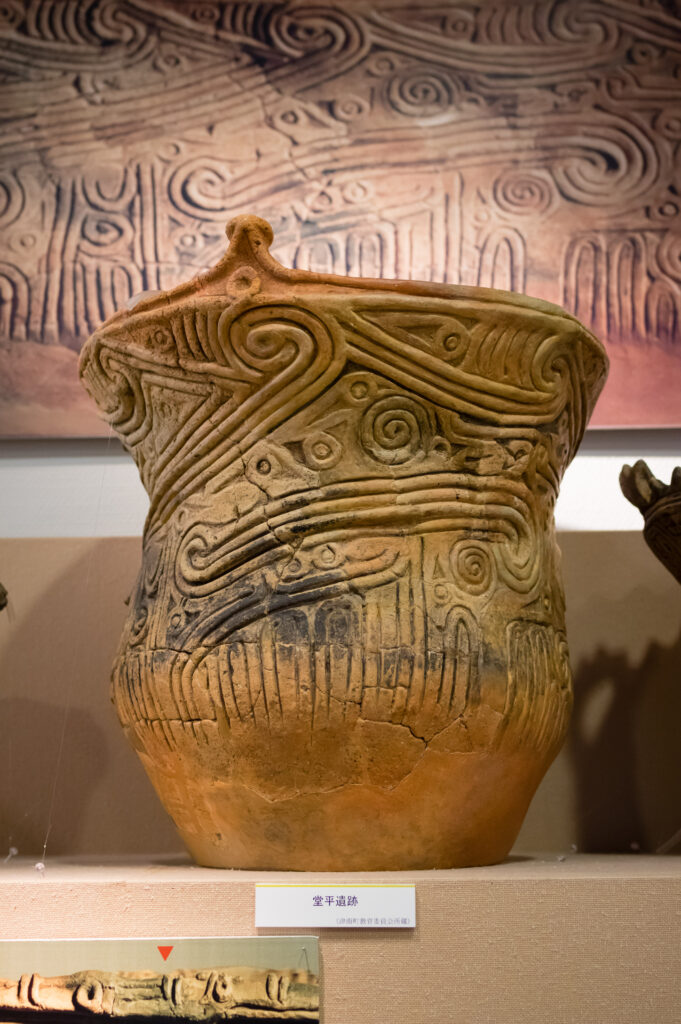
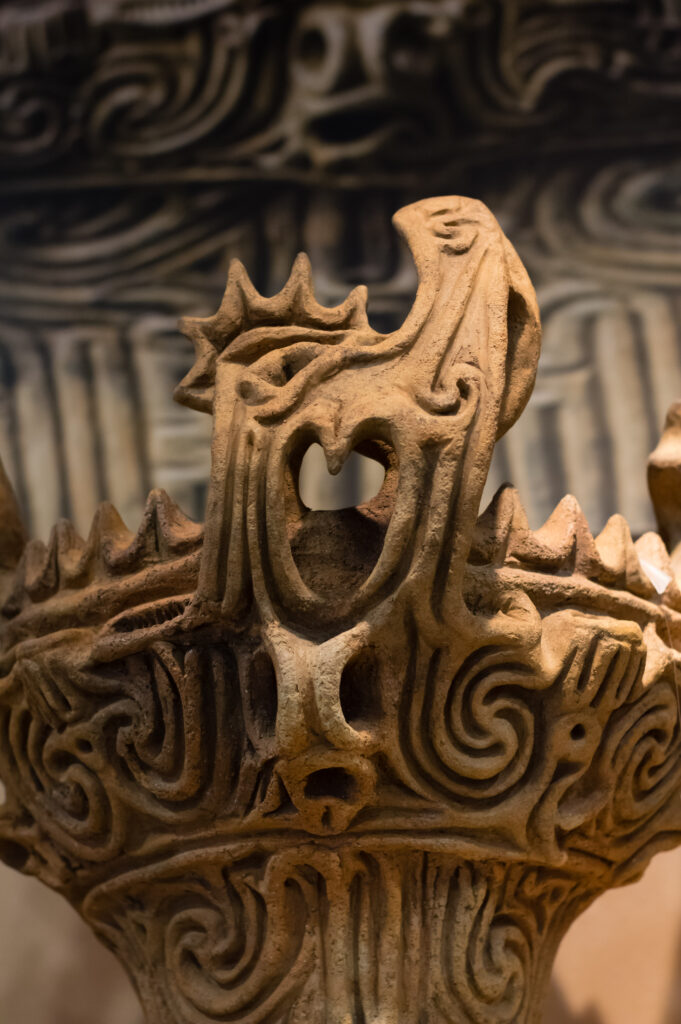
それまで私は、なんとなくの思い込みで、あのようなエネルギッシュな土器だから、誰かがオリジナルでゼロからつくったのかと思っていた。すごい土器名人がいて、「わがムラのオリジナル土器をつくろう」とか、そういう機運が生まれたのかと。
しかし、どうやらそうではないらしい。
慎重に何かを確かめるように、少しずつ文様が足されていくのだ。それをみて、マイナーチェンジを繰り返す車のようだと思った。
しかし、車のマイナーチェンジというものは、販売台数を上げるという利益の追求を目的としているはず。貨幣のない縄文時代は求めているものが決定的に違う気がした。いったい土器のデザインを変えることにはどのような狙いがあったんだろう。そもそも文様って何?
それを確かめるには、当時の信濃川流域の社会で共有されていた世界観が何だったのかを知る必要があるのだと思う。でも、どうやったら5500年も前に生きた人々の世界観に近づくことができるんだろう。
そして、唐突に「遺跡に行こう」と思った。
草刈朋子:文 廣川慶明:写真
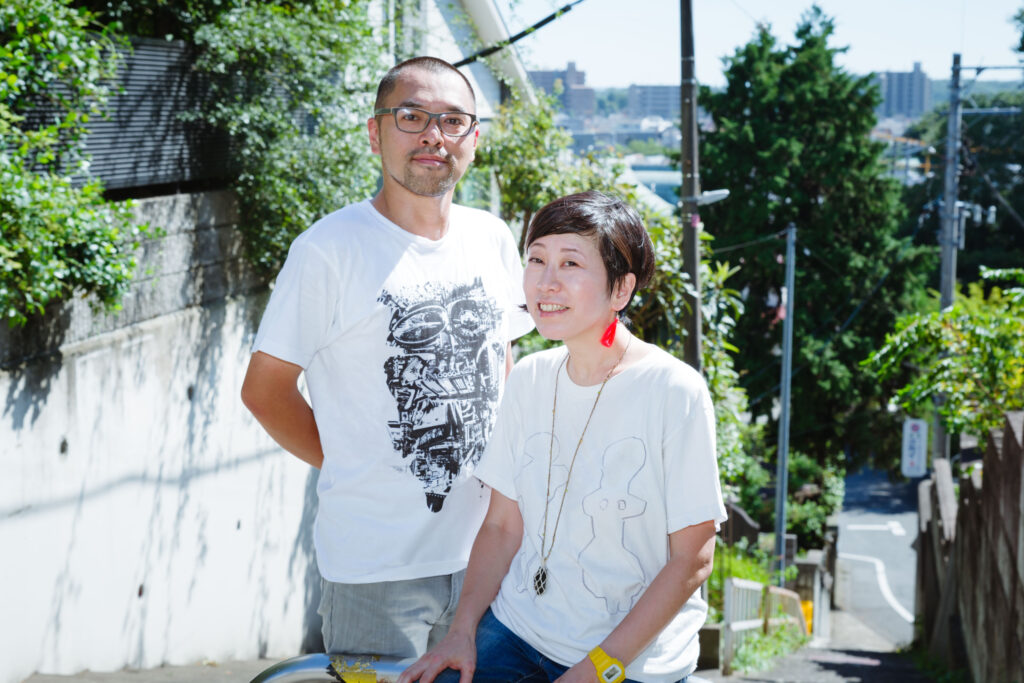
縄と矢じり
文章担当の草刈朋子と写真担当の廣川慶明による縄文探求ユニット。ともにNPO法人jomonismのメンバーとして活動するほか、全国の縄文遺跡と考古館や郷土館をめぐる縄文旅をしながら各地の縄文のカタチ、環境から読み解ける先史時代の価値観を探求中。
http://nawatoyajiri.com
Visiting different areas and exploring the Jomon culture of each place is like creating a map of the Jomon period in your mind. Whether you are in a city or in the countryside, you can find Jomon ruins in almost every place. If you go to the rivers and beaches in the neighborhood, you can even find stones that were used to make stone tools. As I mapped out the elements of the Jomon period one by one on the map in my brain, I began to find it interesting to go to empty ruins where there was nothing but grass. It was right around this point that I began such a journey.
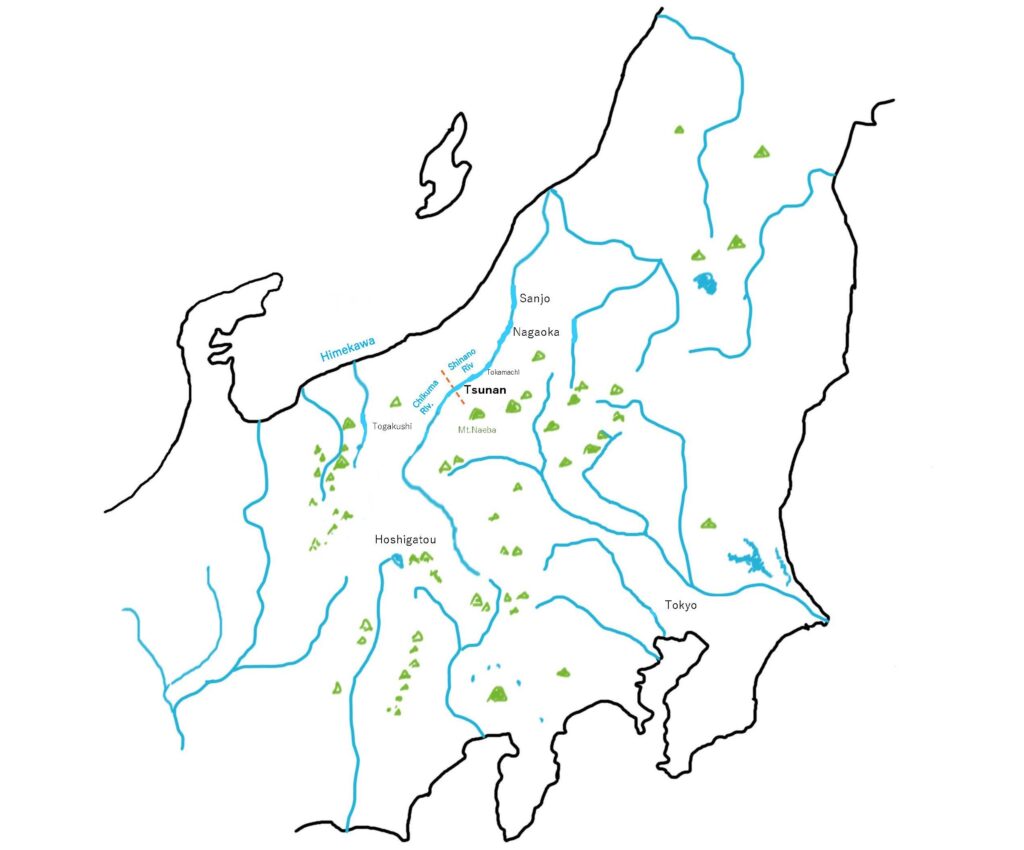
One year in May, we went to a campground in Togakushi Village, Nagano Prefecture. On this occasion, it rained heavily in the middle of the night on the first day, and the front room of our two-room tent was flooded. The rest of the day, however, was fine, and we drove through the magnificent scenery of the Togakushi mountain range, ate the famous soba noodles, found the Geopark Museum and immersed ourselves in the deep world of geology, and enjoyed a bonfire at night. We were so accustomed to the camping days that we didn’t want to go back to our daily lives in Tokyo. When we looked up the surrounding area on a map app, we found that one of the places where Jomon Vessel with Flame-like Ornamentation was excavated was Tsunan Town in Niigata Prefecture, about an hour and a half drive from Togakushi. The town is not so far from here. I immediately took a hotel in Tokamachi, which is next to Tsunan.

We loaded our camping tools into the car, and Hirokawa drove from Togakushi village, past Lake Nojiri and the Madarao Kogen, to choose the road that joins the Chikuma River at Iiyama City. The Chikuma River, once swollen in the Iiyama Basin, enters the mountainous area again and becomes narrower and narrower. The place where the Chikuma River changes its name to the Shinano River is Tsunan Town.
At that time, I was interested in the roads of the Jomon period, and naturally thought that there must have been a road that went along the river. This is because the upper reaches of the Chikuma River are home to Hoshigatou, one of the largest obsidian production areas in Japan. Obsidian is a necessary material for making arrowheads for hunting, and during the Jomon period, obsidian from Hoshigatou was transported around eastern Japan and as far away as Hokkaido. As one of the trade routes, some Jomon people may have traveled along this river…… The fresh green Chikuma River was the perfect place to let my imagination grow.
Eventually, a sign for Niigata Prefecture appeared and we entered Tsunan Town. We passed a sign that said, “Japan’s largest river terrace, Tsunan,” and drove through the quiet downtown area to Tsunan Agriculture and Jomon Era Experience Training Hall Najomon. This was my second time here, but the huge replica of Jomon Vessel with Flame-like Ornamentation at the entrance made me feel that I was in the land of flames.
Jomon Vessel with Flame-like Ornamentation, named for its shape like a blazing fire. The powerful design of the four distinctive “chicken head crowns” dancing on the jagged, wavy edges is always exciting to see. The artist Taro Okamoto described the time he spent with Jomon earthenware as a “dialogue with the fourth dimension,” and the intricate spirals have a psychedelic feel that seems to distort the space, creating a truly four-dimensional form.
The people who made this must have had some pretty crazy sense of humor….. For a while, I enjoyed the large Jomon Vessel with Flame-like Ornamentation in the display case in the lobby. Next, I went to the mini-corner by the wall, where there was a collection of earthenware from Tsunan before and after the birth of the Jomon Vessel with Flame-like Ornamentation.

“Wait…”
There was a row of pottery that looked as if it had been sliced off from the neck up, the most ornate part of the Jomon Vessel with Flame-like Ornamentation.
The earthenware resembled the earthenware of the Noto Peninsula that I saw when I traveled to Hokuriku alone last year, in terms of the whiteness of the clay and the patterns on it. The earthenware of Noto was generally very carefully made, and I felt that it was the origin of the meticulous and delicate craftsmanship of Hokuriku. I wondered if the same pottery culture had spread here in Tsunan.
The pottery had a very stylish appearance. The pottery had a very stylish appearance. The characteristic “chicken head crown” and the jagged, wavy rim were neatly cut – not cut, but not originally there.- and the shape of the pottery, while distinctive, is very simple. In the case of the Jomon Vessel with Flame-like Ornamentation, the vertical ridge lines were placed diagonally, which gave the impression of sophistication.
However, the Jomon may have thought that this was not enough, and as we move forward, the body becomes thinner, and a small ring-like ornament is added to the rim. In addition, a very modest protrusion appears. The rim has jagged edges and four handles. The result is the characteristic shape of the Jomon Vessel with Flame-like Ornamentation.
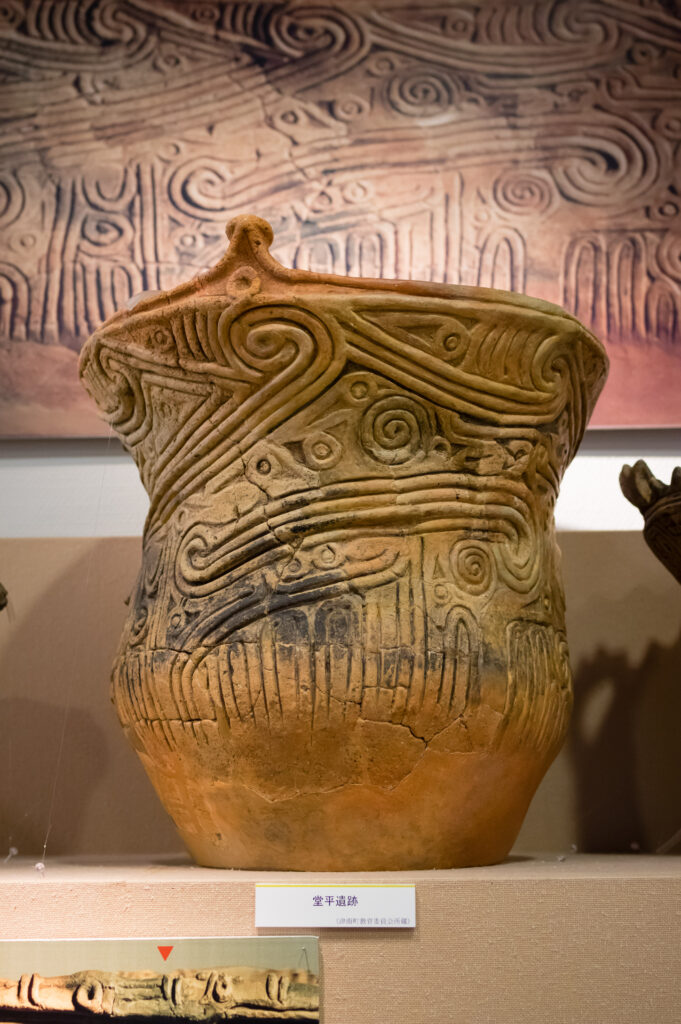
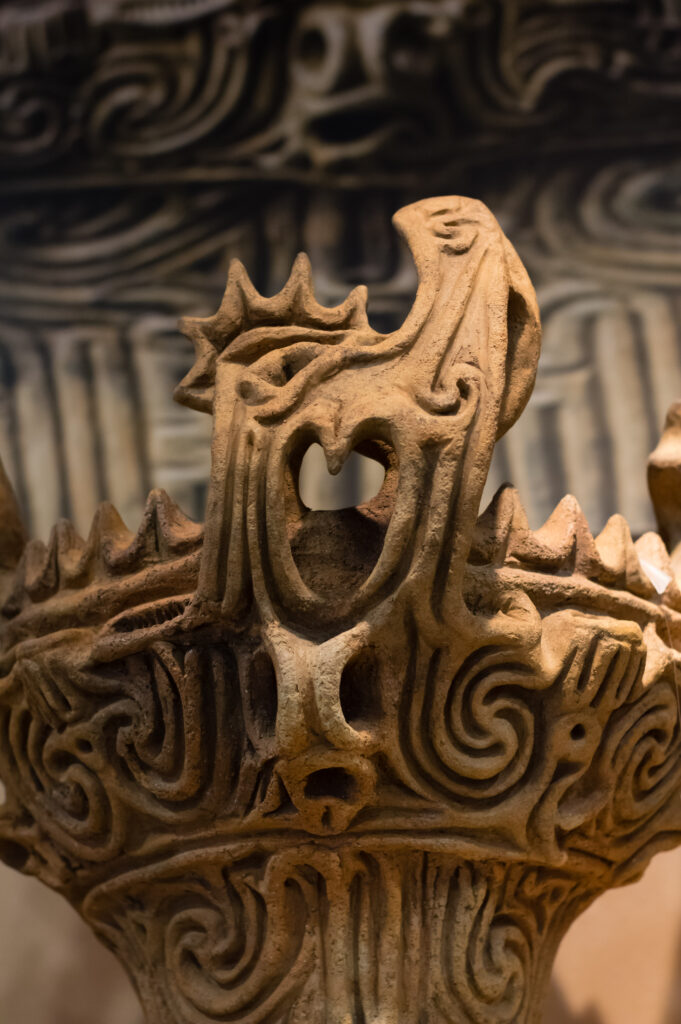
Until then, I had just imagined that someone had created such energetic earthenware from scratch. I guess there were great masters of earthenware, and there was a momentum to ” create original earthenware for our village” or something like that.
However, it seems that this is not the case.
The patterns were added little by little, as if carefully checking something. Seeing this, I thought it was like a car undergoing a series of minor changes.
But, a minor change in a car is supposed to be for the purpose of pursuing profit, which is to increase the sales volume. I felt that the Jomon period, when there was no such thing as money, was definitely different from what people were looking for. What was the purpose of changing the design of the pottery?
What is a pattern anyway?
To find out for sure, I think it is necessary to know what was the shared worldview of the society in the Shinano River basin at that time. But how can we get closer to the worldview of people who lived 5,500 years ago?
Then, suddenly, I thought, “Let’s go to the ruins.”
To be continued in second volume.
Text : Tomoko Kusakari, Photo : Yoshiaki Hirokawa
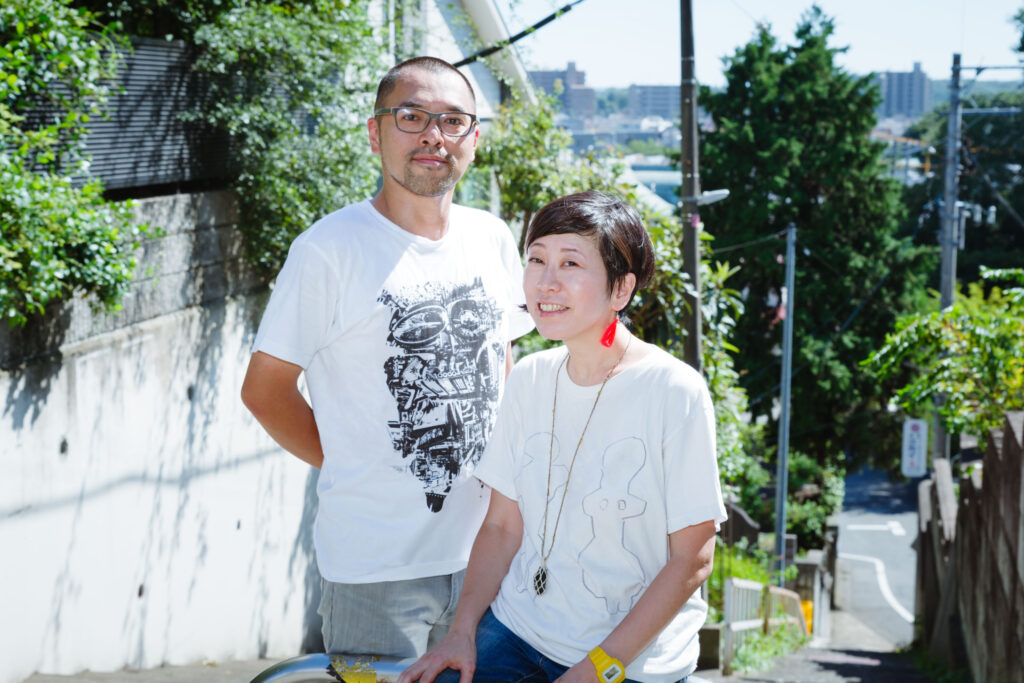
nawa to yajiri
(it means “Rope and Arrowhead”)
A unit for exploring the Jomon by Tomoko Kusakari (writing) and Yoshiaki Hirokawa (photography).
In addition to working as members of the NPO Jomonism, they also travel around Japan visiting Jomon ruins, archaeological sites and local museums, exploring the prehistoric values that can be deciphered from the forms and environments of the Jomon.
http://nawatoyajiri.com